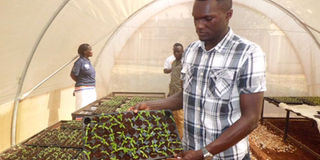How to raise vegetables seedlings in greenhouses

Ivan Sekanjako explains the best practices of using greenhouse technology to grow vegetables. Photo by Lominda Afedraru
What you need to know:
Ivan Sekanjako, a research technician with IITA, explains that the vegetables of priority include tomatoes, sweet pepper and onions, writes Lominda Afedraru
Farmers growing various vegetables across the country have been having a tendency of raising seedlings in open nursery beds which according to experts is not a recommended practice.
The same applies to transplanting the seedlings in vegetable farms where farmers control pest and disease infection using pesticides.
The appropriate control measure is using biological agents processed from living organisms to eradicate pests which are also living organisms. As such scientists from the International Institute of Tropical Agriculture (IITA) have been training farmers in the districts of Mukono and Wakiso on best practices of how to raise vegetables seedlings in green houses using biological agents.
This has been ongoing since 2015 under a project funded by Austrian Development Agency through IITA in partnership with Volunteer Efforts for Development (VEDCO) and Real Intergraded Pest Management (IPM) suppliers of biological agents.
Seeds of Gold had the opportunity to interact with farmers and experts at their demonstration farm in Kyetume village, Mukono.
Preparation of seed bed in screen house
Ivan Sekanjako, a research technician with IITA, explains that the vegetables of priority included tomatoes, sweet pepper and onions although farmers can still apply the same criteria for raising seedling of other vegetable varieties which require transplanting.
What is required is for farmers to acquire a tray containing 66 small holes in which they will pack cocopeat soil which acts as growth media for the seed. Cocopeat is a multi-purpose growing medium made out of coconut husk. It is sterile type of soil with each block weighing five kilogrammes. Farmers are able to use one block of soil in six trays containing 66 holes. In each hole, one seed of the vegetable is dropped ready for growth. The seed must be soaked in the biological agent before planting. These agents depend on the type and they boost the immunity of the plant to resist pests and diseases and it boosts the growth of the seedlings.
Farmers must ensure they purchase clean seed from reputable seed companies. Avoid using ordinary soil because it contains pathogens.
By raising the seedlings in trays, it is easy and portable for transplanting and easy to transport to any farm location. It takes one month for the seedlings to grow, ready for transplanting.
Types of biological agents
The recommended biological agents which are described as living organisms used to control pathogens include trichoderma fungus. This controls soil borne diseases such as nematodes, metalisium used to control pests and basilus among others which is used to control diseases such as powdery mildew. Farmers can also use insecticidal soaps and horticultural oils on soft-bodied insects and mites by following instructions spelt out in the labels.
Later farmers are advised to mix these agents in water and sprinkle on the seedlings. This must be done once every week. This exercise is done in the green house where trays are placed on raised tables to enable smooth growth of the seedlings.
But farmers who may not afford greenhouses can do it inside their houses in an isolated room. This is to avoid infection from pests and diseases.
However, IITA has constructed greenhouses for farmers in Gayaza, Zirobwe and two in Mukono. They are utilising it as a group for raising seedlings and for training other farmers.
What to be done when transplanting
The host farmer in Gayaza, Mathias Kayemba, explains that they are 15 members belonging to Parents Empowering Children and Youth in Uganda.
This farmers association is engaged in raising vegetables seedlings under the healthy seed multiplication system.
Previously, the group was engaged in raising seedlings using the conventional method with the disadvantage of loss of seedlings from pest and diseases and the broadcasting method used for sowing seed was not appropriate.
These farmers are raising seedlings of cabbages, pepper, onions, eggplants, nakati and spider flower on commercial basis. They sell these seedlings to other farmers engaged in vegetable growing.
Prices
Farmers sell different types of vegetable seedlings at different prices, cabbage seedlings are sold at Shs50 per seedling, tomatoes go for Shs300 and Shs500 depending on the variety, spring onions are sold at Shs50 per seedlings.
Others such as beetroot are sold at Shs100 and for vegetables which grown directly from seed such as nakati, the seeds are measured in grammes and the price differs according to quantity purchased.
The team has land in Kasange village Wakiso District where they grow vegetables.
Kayemba explains that after transplanting seedlings of any of the vegetables, it is advisable to continue spraying with biological agents on a weekly basis to prevent pest and disease attack.
The seedlings are planted in lines and continuous irrigation is advisable because vegetables require a lot of water during the growth stage.
Kayemba contends that a farmer who has adopted this new technology will harvest onions of approximately 15 tonnes worth Shs30m.
15,000 heads of cabbage will be harvested 15,000 heads per an acre worth Shs15m. In planting onions, the recommended spacing is 8 centimetres by 40 centimetres and farmers are strictly advised to apply biological agents for better yield, free of pests and disease.
The team is growing these vegetable varieties as a group which is sold and proceeds divided among members.
Kayemba urges farmers engaged in growing vegetables as source of income to adopt this technology by either raising their own seedlings or purchase from colleagues who do the same for commercial purposes.




